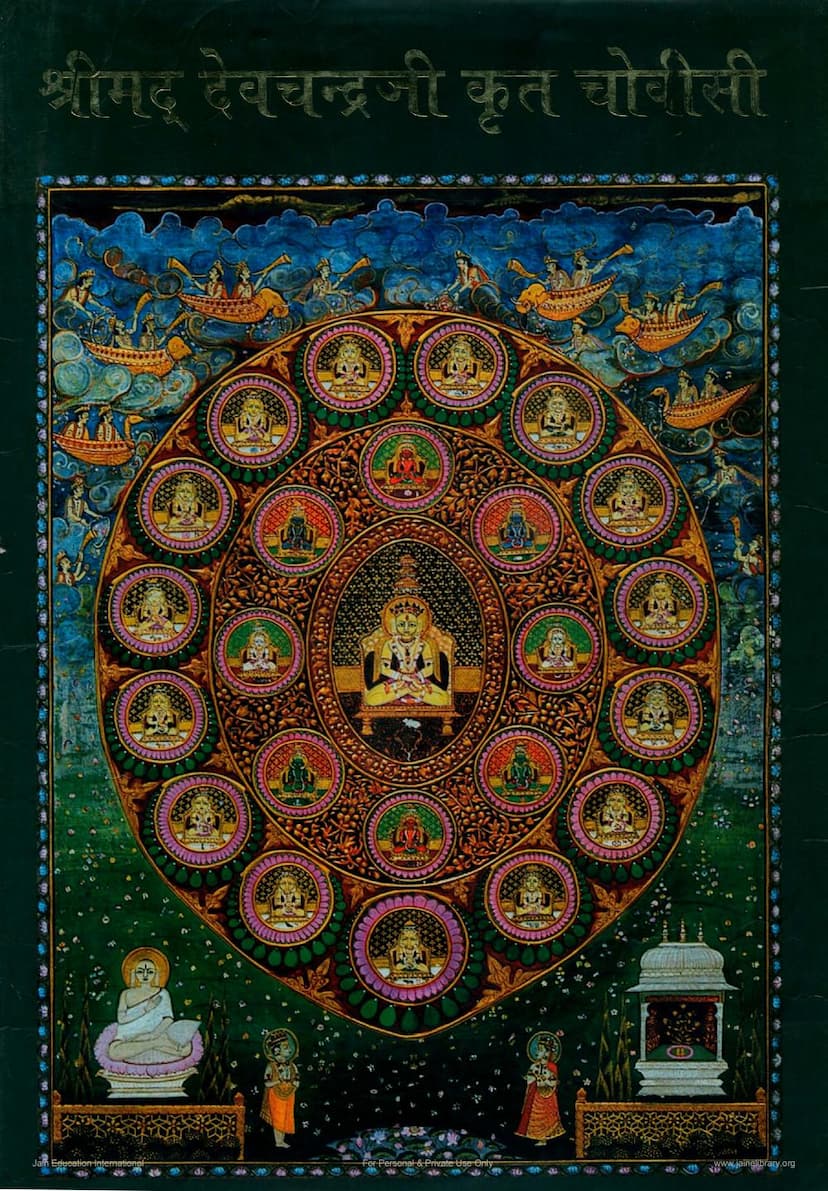Shrimad Devchandji Krut Chovisi
Added to library: September 2, 2025

Summary
Here's a comprehensive summary of the Jain text "Shrimad Devchandji Krut Chovisi," authored by Premal Kapadia and published by Harshadray Heritage, based on the provided text and catalog link:
Overview:
"Shrimad Devchandji Krut Chovisi" is a compilation of devotional hymns (stanzas or verses) composed by the revered Jain monk Shrimad Devchandji. This particular edition is enriched with explanations, summaries, and Hindi translations prepared by Pujya Kalapurnasurishwarji Maharaj Saheb, with editing by Premal Kapadia. The book aims to make the profound spiritual teachings of Devchandji accessible to a wider audience, particularly those seeking to understand and practice the "Paramtatva Ni Upasana" (Worship of the Supreme Element). The first edition was published in Vikram Samvat 2061 (2005 CE).
Core Content and Themes:
The Chovisi (meaning twenty-four, referring to the twenty-four Tirthankaras) consists of twenty-four stanzas, each dedicated to a Tirthankara. These stanzas are not merely eulogies but are deeply philosophical and devotional, elucidating various fundamental principles of Jainism. The text highlights the following key spiritual and philosophical concepts:
- Jinvani Bhakti (Devotion to Jain Teachings): The book strongly emphasizes the importance of devotion to the Tirthankaras and their teachings, viewing it as a primary means for spiritual progress and liberation (Moksha).
- Spiritual Principles: Devchandji's stanzas intricately explore profound spiritual concepts such as:
- Paramtatva Ni Upasana (Worship of the Supreme Element): The core theme revolves around devotion and understanding the nature of the Supreme Reality.
- Shuddha Swaroop (Pure Self): Understanding and realizing the soul's inherent pure nature, free from karmic influences.
- Upadan and Nimitta Karan (Material and Instrumental Causes): Explaining the interplay between the soul's inherent capabilities (material cause) and external factors (like Tirthankara's teachings or grace) that facilitate spiritual realization (instrumental cause).
- Nischay and Vyavahar (Ultimate Truth and Conventional Truth): Differentiating between the absolute truth of the soul's nature and the practical, worldly interactions.
- Atma and Pudgal (Soul and Matter): Differentiating the soul from matter, and understanding their respective qualities and interactions.
- Dravya-Guna-Paryaya (Substance-Attributes-Modifications): Discussing the fundamental Jain metaphysical concepts of substance, its inherent qualities, and its transient modifications.
- Apavada-Utsarga Seva (Specific and General Devotion): Explaining different forms of devotion and service.
- Karyakarna (Cause and Effect): Analyzing the principles of causality in spiritual progress.
- Param Prabhuta (Infinite Greatness of the Tirthankara): Praising the infinite qualities and glory of the Tirthankaras.
- Shadkaraka (Six Agents/Factors): Exploring the six essential principles or agents involved in spiritual practice.
- Vyabadha Sukha (Sorrowless Happiness): Describing the nature of the soul's inherent bliss that is free from worldly suffering.
- Samanya-Vishesha Swabhava (General and Specific Nature): Discussing the dual nature of reality.
- Nihsangata (Non-attachment): The practice of detachment from worldly possessions and relationships.
- Prashasta and Shuddha Bhavaroop Puja (Noble and Pure Devotional Worship): Emphasizing the internal spiritual state during worship.
- Inspirational Poetry: The stanzas are described as "hrudayavedhak" (heart-touching) and, when chanted with remembrance, contemplation, and reflection, lead to happiness and joy. Their recitation during religious rituals like Chaityavandan evokes deep devotion and emotional exaltation.
- Illustrations: The book incorporates ancient Jain artwork, including paintings, border designs, and illustrations from various institutions and private collections. This visual element is intended to enhance the devotional sentiment during the study of the stanzas.
Author and Commentary:
- Shrimad Devchandji: The original author of the Chovisi, renowned for his spiritual insights and devotional poetry. His stanzas are noted for beautifully illuminating spiritual truths, fostering devotion to the Tirthankaras, and guiding towards self-development.
- Pujya Kalapurnasurishwarji Maharaj Saheb: The spiritual guide whose explanations and summaries of the stanzas, along with their essence, are included. His commentary, derived from his extensive work "Paramtatva Ni Upasana," is considered invaluable for understanding the depth of Devchandji'Bhavasagar and spiritual progress.
- Premal Kapadia: The editor of this edition, who has compiled and presented the work with the aim of making Devchandji's Chovisi accessible and understandable to all seekers.
- Pandit Basantilalji Nalwaya (Ratlam): His Hindi translation of "Paramtatva Ni Upasana" was used for the Hindi translation in this book.
Key Features Highlighted:
- Swa-upagna Balavbodh: The book includes original explanations ("Balavbodh") by Devchandji himself, providing simple insights into the stanzas. Old manuscripts from knowledge repositories like 'Koba' were consulted for purification and accuracy.
- Multilingual Presentation: The book includes the original stanzas, Gujarati explanations, and a Hindi translation, making it accessible to a wider audience.
- Artistic Presentation: The inclusion of ancient Jain paintings and illustrations aims to evoke devotion and spiritual appreciation.
- Spiritual Guidance: The book serves as a guide for spiritual seekers, illuminating the path to understanding and internalizing the "Paramtatva Ni Upasana."
Dedication:
The book is humbly dedicated by the editor, Premal Kapadia, to Acharya Dev Shrimad Vijay Kalapurnasurishwarji Maharaj, acknowledging his immense contribution and spiritual guidance.
Overall Significance:
"Shrimad Devchandji Krut Chovisi" is presented as a significant work that makes the profound spiritual legacy of Shrimad Devchandji accessible. Through the detailed explanations and artistic presentation, it aims to foster devotion, spiritual understanding, and ultimately, the path to liberation for its readers. The book is a testament to the compiler's and publisher's dedication to preserving and disseminating Jain spiritual literature.